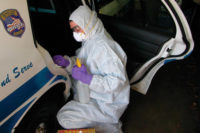It’s mid-April 2014 and David O’Brien, Crime Scene Clean Team/Rapid Responders, is working on a 600 square foot apartment unit. It’s a one-bedroom unit, consisting of a kitchen, bathroom and living area.
But he’s not restoring it to a pre-loss condition from a water or fire damage situation or remediating the property from a mold infestation. No, he’s working to get rid of the unit’s bed bug infestation, a pest problem that’s continuing to become more common across the nation, let alone in Las Vegas where O’Brien is based. In fact, according to a recent report in The Wall Street Journal, bed bugs are well on their way to becoming just as common – if not more common – than cockroaches.
Cities with Most Bed Bug Calls• Cincinnati • Philadelphia • Detroit • New York City • Columbus • Los Angeles • Dallas • Chicago • Houston
• Baltimore |
“The place is just infested,” O’Brien says of the small unit.
O’Brien has been in the trauma scene cleaning business for about 10 years now and started doing bed bug work about five years ago after noticing that the pesky insects were starting to show up at many of the bio-cleaning jobs he and his crew went on.
“We started to see quite a bit of bio on the beds,” O’Brien says. “We’re dealing with the bio anyway, so let’s see what’s causing this. Let’s take care of it. To rectify (the problem), you have to remove the source, whatever that is. And in many situations, the source happens to be the bed bugs.”
But bed bugs are different from your typical pest – mainly because they’re expert hiders. It’s this trait that largely dictates the treatment method used to resolve the infestation. There are several different treatment options available, such as heat treatment (a reason why many in the restoration field are adding this service to their offerings), chemical pesticides, or a combination of both. O’Brien prefers the heat treatment method – but he applies the heat in a different manner than many. Instead of solely pumping the home or apartment full of heat, he also packs out the contents of the home into a storage pod. It’s there that he also administers the 140-plus degree heat, a temperature that’s hot enough to effectively kill mature bed bugs as well as their eggs.
By treating in this way, O’Brien says, he can make sure that the cold spots (i.e. places where the heat can’t penetrate effectively in the home, potentially leading to a bed bug’s survival) are taken out of the question.
“Everything gets treated,” he says. “Carpet, carpet padding – it all needs to be ripped out. Because they can hide. The heat can just go to certain areas, it can’t go all the way. So everything should come out and be treated. And then, everything goes back inside.”
O’Brien says the average bed bug job takes about 4 to 6 hours and consists of anywhere from 2 to 8 professionals. And by heat treating storage units with packed out contents and then treating the empty living area, all bed bugs can be killed in one day, eliminating the need for return treatment trips.
“A lot of people are upset because they spend a lot of money treating and re-treating and re-treating and re-treating,” he says. “Why retreat? Why do you have to retreat? It should be a one-time thing. If you do a good job, there’s no need for you to go back.”
Cities with Greatest Increase in Bed Bug Complaints• Sacramento (54%) • Milwaukee (53%) • Las Vegas (50%) • Columbus (47%) • Baltimore (46%) • Riverside-San Bernardino, CA (41%) • St. Louis (40%) • Cleveland (36%) • Louisville (31%) • Denver (28%) • Los Angeles (27%) • San Francisco (26%) • Dallas/Fort Worth (25%) • Nashville (17%)
• Houston (15%) |
While O’Brien’s bed bug treating method is a step or two more advanced than the means that many other professionals take, there’s another thing that separates him from much of his competition – and that’s his experience in the bio-hazard field and the safety precautions he and his staff take when entering a job.
“A lot of these companies, they haven’t got a clue about bio-hazards,” he says. “When these bugs are biting, they’re filling up with blood and they’re popping. Human blood, potentially infectious disease that these things are carrying.”
Since O’Brien “never knows what he’s walking into,” he and his staff suit up from head to toe in suits, with full-face respirators, booties and gloves. He’ll even go as far as duct taping flaps and zippers to ensure that he and his staff are air tight.
A little extreme? Perhaps. But as O’Brien says, “We don’t want to be taking these things into our vehicles, taking them home to our loved ones.
“It’s all about safety, first and foremost. The money is going to be there, don’t think about money. Think about helping your client. Think about safety for yourself and your co-workers. Safety, safety, safety and safety.”
And the other big thing involved in successfully treating bed bug infestations? Training.
“(Bed bug remediation) can be advantageous, but the problem is you need to get the proper training,” O’Brien says. “Everybody is all, ‘I’ve got the best equipment – my stuff does this, my stuff does that.’ Get the proper training so you know what you’re doing.”








Report Abusive Comment